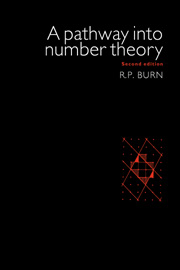Book contents
- Frontmatter
- Contents
- Preface to the second edition
- Introduction
- 1 The fundamental theorem of arithmetic
- 2 Modular addition and Euler's ɸ function
- 3 Modular multiplication
- 4 Quadratic residues
- 5 The equation xn + yn = zn, for n = 2, 3, 4
- 6 Sums of squares
- 7 Partitions
- 8 Quadratic forms
- 9 Geometry of numbers
- 10 Continued fractions
- 11 Approximation of irrationals by rationals
- Bibliography
- Index
- Frontmatter
- Contents
- Preface to the second edition
- Introduction
- 1 The fundamental theorem of arithmetic
- 2 Modular addition and Euler's ɸ function
- 3 Modular multiplication
- 4 Quadratic residues
- 5 The equation xn + yn = zn, for n = 2, 3, 4
- 6 Sums of squares
- 7 Partitions
- 8 Quadratic forms
- 9 Geometry of numbers
- 10 Continued fractions
- 11 Approximation of irrationals by rationals
- Bibliography
- Index
Summary
The construction of the Pathway
Have you attended a mathematics lecture, followed each step of the argument, and yet at the end felt that you did not understand what it was about? Have you read a proof of a theorem in a book and felt the same? If so, you have experienced a feeling common to most mathematicians.
This book on number theory has been put together by keeping a record of how I actually resolved the blocks which I encountered as I read a number of standard texts. Time and again, it was the exploration of special cases which illuminated the generalities for me. This collection of explorations was then organised into a sequence in such a way that the ‘pathway’ would climb towards the standard theorems which occur here as problems for the student at the end of each section.
The motivation for assembling the Pathway was a college need to mount a course for which lectures would not be given. If the Pathway is more successful than some other books or undergraduate lecture courses in number theory, it is because it follows more closely than usual the natural process of discovery, and puts logic in its proper place. The purpose of rigour', said Hadamard, ‘is to legitimate the conquests of the intuition, and it has never had any other purpose’.
- Type
- Chapter
- Information
- A Pathway Into Number Theory , pp. xiii - xviPublisher: Cambridge University PressPrint publication year: 1996

